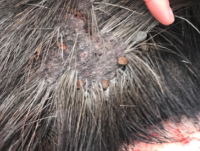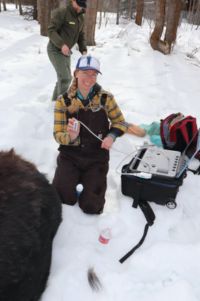Author: Virginia Stout, Ben Wise, Aly Courtemanch, Gary Fralick, Hank Edwards, Samantha Allen, Deborah McCauley
Organization: Veterinary Initiative for Endangered Wildlife (VIEW) and Wyoming Game and Fish Department (WGFD)
Title: Morbidity and Mortality Investigation Along with Human-Moose Coexistence in Jackson, WY
 Jackson, Wyoming is known for its idealistic scenery and keystone wildlife species. Shiras Moose (Alces alces shirasi), in and around Jackson, are one of those iconic species and live in very close proximity to humans. Some moose in the study area have become urbanized, and this greatly increased human wildlife conflict/interaction compared to moose in other areas of the region. Some individuals have completely abandoned migration efforts and reside solely in the more urbanized settings, while others migrate seasonally to more traditional moose range. This unique situation creates challenges for both humans and moose. These challenges include increased vehicle mortalities, accidental poisoning, property destruction, aggressive encounters with people, and greater potential for disease transmission between and among species.
Jackson, Wyoming is known for its idealistic scenery and keystone wildlife species. Shiras Moose (Alces alces shirasi), in and around Jackson, are one of those iconic species and live in very close proximity to humans. Some moose in the study area have become urbanized, and this greatly increased human wildlife conflict/interaction compared to moose in other areas of the region. Some individuals have completely abandoned migration efforts and reside solely in the more urbanized settings, while others migrate seasonally to more traditional moose range. This unique situation creates challenges for both humans and moose. These challenges include increased vehicle mortalities, accidental poisoning, property destruction, aggressive encounters with people, and greater potential for disease transmission between and among species.
 To further complicate the issues, moose populations have been in decline across the southern extent of their range in North America during the past 25 years. The decline has been attributed to several factors including climate change, habitat encroachment/ fragmentation, predation, and disease with parasites being the most concerning. Moose in the eastern states and Minnesota have been well studied, but limited information is available for moose in western states. The Jackson area specifically has had cyclical local mortality events over the last several decades with documentation of up to 30-50 moose dying of unknown causes during one winter season. This level of mortality is a statistically significant portion of the population, and limited information and confirmatory diagnostics was gathered at the time. Our study aims to investigate the causes of moose morbidity and mortality in the Jackson area and how it relates to human interactions.
To further complicate the issues, moose populations have been in decline across the southern extent of their range in North America during the past 25 years. The decline has been attributed to several factors including climate change, habitat encroachment/ fragmentation, predation, and disease with parasites being the most concerning. Moose in the eastern states and Minnesota have been well studied, but limited information is available for moose in western states. The Jackson area specifically has had cyclical local mortality events over the last several decades with documentation of up to 30-50 moose dying of unknown causes during one winter season. This level of mortality is a statistically significant portion of the population, and limited information and confirmatory diagnostics was gathered at the time. Our study aims to investigate the causes of moose morbidity and mortality in the Jackson area and how it relates to human interactions.
The hypothesis of this study is that disease, especially parasites such as winter tick (Dermacentor albipictus) and arterial worm  (Elaeophora schneideri), plays a significant role in moose morbidity and mortality with urbanized moose being more susceptible to mortality. As part of this study we are currently analyzing biological samples from mortalities and from live moose captured during the next two winters. Potential causes of mortality will be determined and will provide a greater understanding of the disease dynamics in this herd. With increased global human populations and development/ fragmentation of habitat, increased pressure and stress is placed on wildlife, including moose. Human- wildlife coexistence is vital for the conservation of wildlife. Understanding morbidity and mortality factors along with human- moose interactions will help to formulate solutions for the future.
(Elaeophora schneideri), plays a significant role in moose morbidity and mortality with urbanized moose being more susceptible to mortality. As part of this study we are currently analyzing biological samples from mortalities and from live moose captured during the next two winters. Potential causes of mortality will be determined and will provide a greater understanding of the disease dynamics in this herd. With increased global human populations and development/ fragmentation of habitat, increased pressure and stress is placed on wildlife, including moose. Human- wildlife coexistence is vital for the conservation of wildlife. Understanding morbidity and mortality factors along with human- moose interactions will help to formulate solutions for the future.
Photo credits: Virginia Stout

Dr. Virginia Stout is a veterinarian with experience in wildlife capture, field surgery, research, and disease surveillance. She has worked in many different environments, including sites across the U.S., Canada, South Africa, and Nepal. She currently works for VIEW. She graduated from Auburn University Veterinary School and has a Masters of Conservation Medicine from Tufts University. She lives in Jackson, WY and works part time as a clinical veterinarian.
